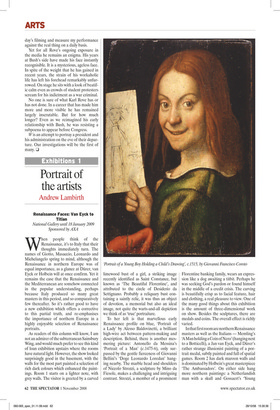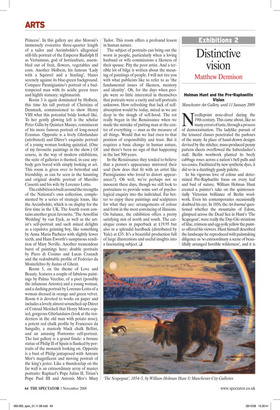Portrait of the artists
Andrew Lambirth
Renaissance Faces: Van Eyck to Titian National Gallery until 18 January 2009 Sponsored by AXA When people think of the Renaissance, it’s to Italy that their thoughts immediately turn. The names of Giotto, Masaccio, Leonardo and Michelangelo spring to mind, although the Renaissance in northern Europe was of equal importance, as a glance at Dürer, van Eyck or Holbein will at once confirm. Yet it remains the case that the Renaissance and the Mediterranean are somehow connected in the popular understanding, perhaps because Italy produced so many great masters in this period, and so comparatively few thereafter. So it’s rather good to have a new exhibition which offers a corrective to this partial truth, and re-emphasises the importance of northern Europe in a highly enjoyable selection of Renaissance portraits.
As readers of this column will know, I am not an admirer of the subterranean Sainsbury Wing, and would much prefer to see this kind of loan exhibition upstairs where the rooms have natural light. However, the show looked surprisingly good in the basement, with the walls for the most part painted a selection of rich dark colours which enhanced the paintings. Room 1 starts on a lighter note, with grey walls. The visitor is greeted by a carved limewood bust of a girl, a striking image recently identified as Saint Constance, but known as ‘The Beautiful Florentine’, and attributed to the circle of Desiderio da Settignano. Probably a reliquary bust containing a saintly relic, it was thus an object of devotion, a memorial but also an ideal image, not quite the warts-and-all depiction we think of as ‘true’ portraiture.
To her left is that marvellous early Renaissance profile on blue, ‘Portrait of a Lady’ by Alesso Baldovinetti, a brilliant high-wire act between pattern-making and description. Behind, there is another mesmering picture: Antonello da Messina’s ‘Portrait of a Man’ (c.1475-6), only surpassed by the gentle fierceness of Giovanni Bellini’s ‘Doge Leonardo Loredan’ hanging nearby. The marble head and shoulders of Niccolo Strozzi, a sculpture by Mino da Fiesole, makes a challenging and intriguing contrast. Strozzi, a member of a prominent Florentine banking family, wears an expression like a dog awaiting a titbit. Perhaps he was seeking God’s pardon or found himself in the middle of a credit crisis. The carving is beautifully crisp as to facial feature, hair and clothing, a real pleasure to view. One of the many good things about this exhibition is the amount of three-dimensional work on show. Besides the sculptures, there are medals and coins. The overall effect is richly varied.
In that first room are northern Renaissance masters as well as the Italians — Memling’s ‘A Man holding a Coin of Nero’ (hanging next to a Botticelli), a Jan van Eyck, and Dürer’s rather strange illusionist painting of a portrait medal, subtly painted and full of spatial games. Room 2 has dark maroon walls and is dominated by Holbein’s great masterpiece ‘The Ambassadors’. On either side hang more northern paintings: a Netherlandish man with a skull and Gossaert’s ‘Young Princess’. In this gallery are also Moroni’s immensely evocative three-quarter length of a tailor and Arcimboldo’s allegorical still-life portrait of the Emperor Rudolph II as Vertumnus, god of horticulture, assembled out of fruit, flowers, vegetables and corn. Another Holbein, his famous ‘Lady with a Squirrel and a Starling’, blazes serenely against its blue-green background. Compare Parmigianino’s portrait of a badtempered man with its acidic green trees and highlit statuary: nightmarish.
Room 3 is again dominated by Holbein, this time his tall portrait of Christina of Denmark, commissioned to show Henry VIII what this potential bride looked like. To her gently glowing left is the scholar Peter Gillis by Quinten Massys, reminiscent of his more famous portrait of long-nosed Erasmus. Opposite is a lively Ghirlandaio (attributed) and Dürer’s exquisite portrait of a young woman looking quizzical. (One of my favourite paintings in the show.) Of course, in the way of modern exhibitions, the suite of galleries is themed, in case anybody gets bored with simply looking at art. This room is given over to betrothal and friendship, as can be seen in the haunting and original double portrait of Marsilio Cassotti and his wife by Lorenzo Lotto.
The exhibition is built around the strengths of the National’s own collection, complemented by a series of strategic loans, like the Arcimboldo, which is on display for the first time in the UK. The fourth room contains another great favourite, ‘The Arnolfini Wedding’ by van Eyck, as well as the artist’s self-portrait and such mixed delights as a repulsive grinning boy, like something by Anna Maria Pacheco with slightly fewer teeth, and Hans Eworth’s sumptuous rendition of Mary Neville. Another tremendous burst of paintings here: double portraits by Piero di Cosimo and Lucas Cranach and the redoubtable profile of Federico da Montefeltro by Justus of Ghent.
Room 5, on the theme of Love and Beauty, features a couple of fabulous paintings by Palma Vecchio, of a poet (possibly the infamous Ariosto) and a young woman, and a dashing portrait by Lorenzo Lotto of a woman dressed in orange and green velvet. Room 6 is devoted to works on paper and includes a lovely almost scrunched-up Dürer of Conrad Merckell that Henry Moore copied, gorgeous Ghirlandaios (look at the tenderness in the old man with potato nose), a potent red chalk profile by Francesco da Sangallo, a masterly black chalk Bellini, and an amusing Pontormo self-portrait. The last gallery is a grand finale: a bronze statue of Philip II of Spain is flanked by portraits of the monarch looking on. Opposite is a bust of Philip juxtaposed with Antonis Mor’s magnificent and moving portrait of the king’s jester. Like a thunderclap on the far wall is an extraordinary array of master portraits: Raphael’s Pope Julius II, Titian’s Pope Paul III and Antonis Mor’s Mary Tudor. This room offers a profound lesson in human nature.
The subject of portraits can bring out the worst in people, particularly when a loving husband or wife commissions a likeness of their spouse. Pity the poor artist. And a terrible lot of bilge is written about the meaning of paintings of people. I will not tire you with what publicists like to refer to as ‘the fundamental issues of likeness, memory and identity’. Oh, for the days when people were so little interested in themselves that portraits were a rarity and self-portraits unknown. How refreshing that lack of selfabsorption would be today, mired as we are deep in the slough of self-hood. The rot really began in the Renaissance when we made the mistake of putting man at the centre of everything — man as the measure of all things. Would that we had risen to that position of responsibility and trust. But it requires a basic change in human nature, and there’s been no sign of that happening in the last 500 years.
In the Renaissance they tended to believe that a person’s appearance mirrored their soul (how does that fit with an artist like Parmigianino who loved to distort appearances?). Oh well, we’re perhaps not so innocent these days, though we still look to portraiture to provide some sort of psychological enquiry into the individual. Far better to enjoy these paintings and sculptures for what they are: arrangements of colour and form in the most convincing of illusions. On balance, the exhibition offers a pretty satisfying mix of north and south. The catalogue comes in paperback at £19.95 but also in a splendid hardback (distributed by Yale) at £35. It’s a beautiful production full of large illustrations and useful insights into a fascinating subject. ❑



































































































 Previous page
Previous page